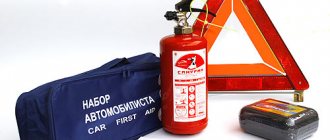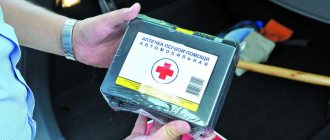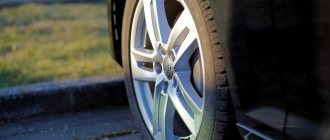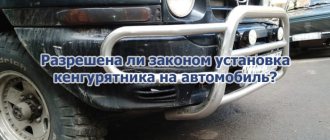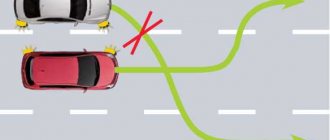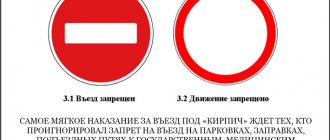Every driver should know the options for developing a situation in which a traffic police inspector has the right to check the presence of a first aid kit and a fire extinguisher in a vehicle, and also issue a fine for their absence in 2021. The further development of the situation and the possible outcome of the dispute with a representative of the law will depend on legal awareness. With a favorable set of circumstances and well-structured defense, you can defend your rights and point out gaps in the traffic police inspector’s knowledge of traffic rules.
Can the traffic police inspector check the presence of a first aid kit and fire extinguisher?
The traffic police inspector has a wide range of rights in relation to drivers, especially if he notices a traffic violation. Regarding the traffic police officer’s demands to show him a first aid kit and a fire extinguisher to check for availability, every motorist must remember that such requests will be illegal in 2021. In clause 2.1.1 of the traffic rules it is clearly established that, at the direction of the traffic police inspector, the driver must present only the MTPL insurance policy and documents for the car, namely: a vehicle registration certificate, a driver’s license. If there is a “disabled person” sign on the vehicle, document your belonging to this category of citizens.
Attention! If you have any questions, you can chat for free with a lawyer at the bottom of the screen or call Moscow; Saint Petersburg; Free call for all of Russia.
A first aid kit and fire extinguisher are not included in the list of documents required by the inspector.
The presence of a first aid kit and a fire extinguisher is checked during the technical inspection of the vehicle. Based on the results of the procedure, a diagnostic card is issued, which indicates the serviceability of the vehicle and the possibility of its further operation. Therefore, the traffic police inspector’s request to present a first aid kit and fire extinguisher in 2021 will simply be illegal. The only way to see the first aid kit in the vehicle is for the inspector to inspect the vehicle.
Expiration date of fire extinguisher and first aid kit
There may also be a fine for an expired first aid kit and fire extinguisher. In 2019, you can also receive an administrative penalty for this as a violation of technical requirements for a car. An expired fire extinguisher is the same malfunction, and therefore entails punishment in accordance with Art. 12.5 of the Administrative Code.
We invite you to read: The bank filed a lawsuit, what to do?
First aid kit contents
In 2021, the requirements for its content have changed significantly. Now the main emphasis is on dressings:
- bandages;
- gauze;
- sterile wipes;
- tourniquets;
- scissors.
Most of these first aid measures for road accidents are aimed at stopping bleeding. Iodine, analgin, validol, nitroglycerin are excluded from the compulsory items for first aid, because they tend to deteriorate quickly in the trunk at high temperatures in the summer.
The driver is obliged to monitor the expiration date of items from the first aid kit and, upon expiration, replace the dressing material and other items. It is impossible to name the general shelf life of a first aid kit, since it may vary for each item. Thus, non-sterile gauze bandages, which are manufactured according to GOST 1172-93, have a limited service life of 5 years.
Each fire extinguisher and its packaging must have a date of manufacture and a guaranteed shelf life. If a portable fire extinguisher has a metal body and can be recharged, then this period cannot be less than 10 years according to the rules of GOST R 51057-2001. If the traffic police inspector finds inconsistencies, he will issue a fine for an expired first aid kit and fire extinguisher.
What is the fine for not having a first aid kit in 2021?
For the absence of a first aid kit in 2021, Article 12.5 of the Code of Administrative Offenses provides for a fine of 500 rubles. The specified amount is fixed and cannot be greater. When imposing an administrative penalty, the traffic police officer may also exercise the right to warn the driver rather than impose a fine. This measure is not popular among inspectors due to its free nature, and drivers simply do not know that there is a chance to take advantage of this opportunity.
Any first aid kit, even one as limited in its range as the one used in 2021 and consisting mainly of bandages and gauze, has an expiration date. This period can be found on the front of the first aid kit, it is printed with printing ink and averages 4 years from the date of manufacture.
An expired first aid kit is the equivalent of a missing first aid kit.
What is the fine for not having a fire extinguisher in 2021?
The mandatory presence of a fire extinguisher in a vehicle is established by the same article 12.5 of the Code of Administrative Offenses as the presence of a first aid kit. Therefore, the fine for not having a fire extinguisher in 2021 will also be 500 rubles. The possibility of imposing a warning instead of a fine also exists.
In order to determine the expiration date for a fire extinguisher, you should pay attention to its type. So, a powder fire extinguisher will last 10 years, but after 5 years it should be recharged. It will be much more profitable to keep a gas fire extinguisher in your car, since its duration is longer. However, it should be checked once a year and recharged every five years.
You should also not forget that if the inspector discovers the absence of a fire extinguisher or an empty cylinder, you can always refer to unforeseen circumstances on the road in which it was urgently necessary to use this fire extinguishing agent. Such situations could be a fire left on the side of the road or smoke under the hood of a passing car. But the employee will still be able to fine him, and everything that is said to justify the driver will only be calculated on the leniency of the inspector.
Search
Inspection is an examination of a vehicle carried out without violating the integrity of the vehicle’s structure to detect instruments or objects of an administrative offense.
There are clearly defined conditions for carrying out the inspection procedure:
- the traffic police officer has reason to believe that there are objects or instruments for committing an offense in the car;
- there are good reasons to check the car for the presence of dangerous substances (ammunition, chemicals, narcotic substances, etc.);
- the driver or passenger of the car was detained administratively.
That is, the inspector does not even have the right to demand an inspection if he simply doubts the presence of a fire extinguisher in the car .
When conducting an inspection, a traffic police officer is required to draw up an inspection protocol , and he must do this immediately before the inspection procedure. It also stipulates that the search is carried out only in the presence of witnesses (at least two) or the procedure must be recorded materially (video recording).
If a traffic police officer ignores these conditions or issues a fine for a fire extinguisher (its absence) in violation of the inspection procedure, then these actions can be appealed administratively, since they fall under the article “Arbitrariness”.
What must be in a car?
It is mandatory, in accordance with clause 2.1.1 of the Traffic Regulations, that the following documents must be present in the vehicle when using it:
- driver's license;
- OSAGO policy;
- vehicle registration certificate.
These documents are presented upon the first request of a traffic police officer. In addition to documents, in accordance with clause 7.7 of Chapter 7 of the Traffic Regulations, the following items established by law must be in the car:
- fire extinguisher;
- first aid kit;
- warning triangle;
- signal vest.
Search procedure
Inspection of a vehicle can only be carried out by authorized police officers (police, traffic police), officials of executive authorities, border guards, customs officers, etc., as defined in Article 27.2-27.3 of the Administrative Code. The inspection procedure itself consists of several stages, which are described in Art. 27.9 of the Code. The authorized employee must comply with the following conditions:
- Involvement of witnesses (witnesses) during the inspection - at least two people;
- Video recording if witnesses cannot be found;
- Drawing up a protocol;
- Delivery of a copy of the protocol to the car owner.
In the protocol, the inspector must indicate the date and time of the examination, his data, including his position, all known information about the owner of the car or the driver in whose presence the procedure is being carried out, and also describe in detail all the things and documents that were discovered (up to to the brand and caliber of the weapon, number of bullets, etc.).
Punishment for driving without a first aid kit is possible only if its absence is discovered during a vehicle inspection. An inspection is an inspection of a car without technically violating its integrity to find items of crime - weapons, ammunition, drugs, dangerous chemicals. The traffic police inspector of a stopped car is obliged to justify the reasons for his actions and draw up a report before the inspection begins. The procedure itself requires the participation of two witnesses or video recording.
We invite you to read: Transferring sick leave to the next year
An inspection is an inspection of a car, carried out without breaking it, in order to identify prohibited items. When carrying out this procedure, the traffic police officer must be sure that there are hazardous substances in the car. The inspector's doubts about the presence of a fire extinguisher do not give the right to conduct an inspection of the vehicle.
Before searching a car, a protocol must be drawn up in the presence of witnesses or a video recording of the entire procedure must be made. Ignoring these conditions must be appealed, since such actions are arbitrariness.
The location of a fire extinguisher, warning triangle, or first aid kit outside the inspector's visibility is not a good enough reason to conduct an inspection of the vehicle. The inspector indicating this reason in the inspection report is a violation of Article 19.1 and the driver’s rights.
After the “introduction”, the conversation turns to the topic of having a fire extinguisher, first aid kit and warning triangle. The driver can demand from the inspector that he name the clause of the traffic rules, according to which it is necessary to present the requested items. If there is no response, the driver must clarify that he has a valid inspection ticket, which gives the car owner the right not to prove the presence of these items in his vehicle.
If the inspector continues to persistently demand, the driver may agree to show the necessary items, but only after drawing up a vehicle inspection report in the presence of two witnesses.
According to paragraph 155 of the Order of the Ministry of Internal Affairs of the Russian Federation, a vehicle inspection can be carried out only on the following grounds:
- reasonable suspicion that there are drugs, weapons or objects in the car that could be used to commit an administrative violation;
- case of detention of the driver of this vehicle.
It follows from this that the driver’s reluctance to comply with the inspector’s demands (especially if the driver has a vehicle inspection ticket) is not the reason for the inspection. If there is still a reason, an inspection will have to be carried out.
The procedure for imposing a fine for the absence of a first aid kit or fire extinguisher
To impose an administrative fine for the absence of a first aid kit or fire extinguisher, the fact of the offense must be properly recorded. These actions can only be carried out by a traffic police inspector by drawing up a protocol on administrative responsibility.
In a situation where there is no fire extinguisher and first aid kit, two scenarios should be considered:
- Drive independently and voluntarily admitted to not having a first aid kit or fire extinguisher.
- The driver refused to admit that there was no first aid kit and fire extinguisher in his car, and this fact was established through an inspection of the vehicle.
In the first case, the traffic police inspector, with the participation of two witnesses or while recording a video, draws up a protocol on the administrative offense and gives a copy of it to the driver. It should be remembered that in 2021 the protocol is not one hundred percent proof of guilt. It will only serve as the basis for drawing up a resolution on an administrative offense. But the resolution will be the basis for imposing a fine for the lack of a first aid kit and fire extinguisher.
The rules for drawing up the protocol are regulated by Art. 28.1 Code of Administrative Offenses of the Russian Federation. The protocol must necessarily contain the location of the offense, the date it was written, the position and name of the traffic police officer who compiled it, as well as information about the offender and the reasons for the detention.
In the second case, when the driver refuses to present a first aid kit and a fire extinguisher for inspection, the traffic police officer will only have to inspect the vehicle. At the same time, a traffic police officer does not have the right to carry out an inspection just for the sake of checking a first aid kit or fire extinguisher. To suppress such actions, the inspector should be reminded of Article 19.1 of the Code of Administrative Offenses “Arbitrariness”. To carry out an inspection, it is necessary to have strong arguments, for example, the presence of a reference to a similar car about the transportation of weapons, drugs, or about the presence of a similar car that was stolen. In such cases, the driver has the right to demand the presentation of an orientation.
If the search could not be avoided, then it should be remembered that it can only be carried out in the presence of two witnesses or with video recording (Article 27.9 of the Administrative Code). In this case, uninterested persons from among other drivers must be witnesses. Traffic police officers are prohibited from involving their partners or trainees as inspectors as witnesses. If this rule is violated, the legality of the protocol drawn up will be easy to challenge.
The car inspection protocol can be found here.
Reasons for checking a car
When stopping a vehicle, a traffic police officer is required to do the following:
- state your position, rank, surname;
- show the identification document in expanded form;
- voice the standard according to which he insists on presenting a fire extinguisher.
Only on this basis is a fine issued for the lack of extinguishing agent. In paragraph 7.7, Chapter 7 of the Traffic Regulations, a list of faults is provided that prohibits the operation of the machine; the absence of a fire extinguisher is also contained in this list.
Mention of the points of orders of the Ministry of Internal Affairs is not mandatory for drivers, since these internal documents are necessary for execution only by traffic police officers. For car owners, the main document to comply with is the traffic rules.
In accordance with the traffic rules, the inspector has the right to check the fire extinguisher, warning triangle and first aid kit only during an inspection.
Many traffic police officers take advantage of drivers’ ignorance and, when stopped, immediately demand to see medical aid, a fire extinguisher or a warning triangle. If the driver does not have these items in the car, they are threatened with a fine. However, such actions fall under Article 19.
The grounds for stopping a car and for inspecting it by a traffic police inspector are not the same and are regulated by different regulations. In the first case, this is the Administrative Regulations established by Order of the Ministry of Internal Affairs No. 664 of August 23, 2017. All reasons are listed in paragraph 84 of this regulation and checking the presence of a first aid kit, fire extinguisher and other items in the car is not included in their number.
In the second case, the grounds for searching the car are regulated by Article 27.9 of the Code of Administrative Offenses. There is really only one legal basis on which an authorized officer can inspect or search a vehicle. Its purpose can only be to detect instruments of crime or items related to an administrative offense.
Inspection is an examination of a vehicle, which does not entail a violation of the integrity of the vehicle’s structure, in order to determine or identify items of violation.
For an inspector to begin inspecting your vehicle, there must be sufficiently compelling reasons. These include:
- the grounds on which a traffic police officer may assume that there are objects or instruments inside the car for committing an administrative offense;
- information about the possible presence of dangerous substances in the car, which include psychotropic, narcotic, chemical and other substances, ammunition;
- administrative detention of the driver or passenger of a car.
You cannot be stopped just to check whether there is a fire extinguisher in your car.
If a decision is made to conduct an inspection, the inspector is obliged, in accordance with the rules:
- draw up an inspection protocol before the process itself takes place;
- the inspection must take place only in the presence of at least 2 witnesses (an alternative solution is to record the process on a video camera).
If these steps are violated, you can appeal the decision by referring to Article 19.1 of the Code of Administrative Offenses of the Russian Federation on arbitrariness.
In this case, the inspector is obliged to indicate to you the standard by which he can require you to present a fire extinguisher and issue a fine for not having it in the car.
We suggest you read: How does hypochlorite affect human health? What are the consequences?
According to paragraph 7.7 of Chapter 7 of the “List of Faults”, in the absence of a first aid kit, fire extinguisher and warning triangle, operation of the vehicle is prohibited.
But also, according to Part 1 of Article 12.5 of the Code of Administrative Offenses of the Russian Federation, operating a car that has a malfunction is prohibited, with the exception of the absence of a first aid kit, a fire extinguisher and an emergency stop sign, which requires an administrative fine of five hundred rubles or a warning.
What should be in a car first aid kit? In 2015, the first aid kit includes only bandages and adhesive plasters. Any medications are prohibited. This phenomenon is due to the fact that many medications at high temperatures, and in the summer it can be up to 50 degrees in the cabin, release toxic substances and deteriorate.
- a tourniquet that stops bleeding;
- non-sterile bandages (5m x 5 cm - 2 pieces, 5m x 10 cm - 2 pieces, 7m x 14 cm - 1 piece, 5m x 7 cm - 2 pieces);
- sterile bandages (5m x 10 cm - 2 pieces, 7m x 14 cm - 1 piece, 5m x 7 cm - 2 pieces);
- dressing package;
- packaging of gauze napkins;
- bactericidal patch (4 x 10 cm - 2 pieces, 1.9 x 7.2 cm - 10 pieces);
- roll plaster (1 x 250 cm - 1 piece);
- resuscitation device for mouth-to-mouth artificial respiration;
- scissors;
- medical gloves;
- recommendations for using a first aid kit;
- case for packaging products.
The price of such a car first aid kit ranges from 150 to 350 rubles. You can purchase it at any auto store, gas station or regular hypermarket.
The absence of a fire extinguisher in the car is punishable by a fine. However, a traffic police officer can only detect a violation during an inspection.
The vehicle inspection procedure, in turn, has a number of rules, compliance with which is strictly regulated by law. The inspector has no right to demand an inspection without objective grounds:
- tips from the police (traffic inspectors) about the presence of prohibited substances in the car: drugs, contraband;
- eyewitness statements about the transportation of prohibited goods in a car;
- video footage of the presence of a hostage in the car, etc.
Car inspection is carried out only if there is an appropriate order, which the traffic police officer must present to the driver. The driver, in turn, has no right to interfere with the actions of law enforcement officers. When inspecting the salon, a protocol is drawn up and signed by witnesses. Based on the conclusion, the driver is fined for not having a fire extinguisher.
Thus, it is impossible to detect the absence of a cylinder in a car without conducting an inspection. However, the traffic police inspector is obliged to ask the driver about the availability of the cylinder and its expiration date.
What should a driver do if a fine is imposed for not having a first aid kit or fire extinguisher?
To ensure that you avoid a fine for not having a first aid kit or fire extinguisher in 2021, you should purchase the necessary items and forget about problems with inspection. However, if punishment is inevitable, one should remember the possibility of persuading the inspector for softer sanctions - a warning. You can take advantage of a similar case if you convince a traffic police officer that the missing parts of bandages or plasters were just used to help a boy cyclist who fell in front of your eyes and broke his knees. But if you find an expired first aid kit, you can tell the inspector that you are currently heading for the first aid kit.
Having passed the technical inspection will guarantee protection from additional checks for the lack of a first aid kit and fire extinguisher. It should also be remembered that a request for the provision of the above items is legal only during the period of technical inspection, and its conduct by a traffic police inspector on the road is illegal.
○ Consequences of not having a first aid kit, fire extinguisher or stop sign.
First of all, you need to remember the traffic rules. It contains a list of faults, as well as other conditions under which the vehicle cannot be used. And among other things, clause 7.7 of this list provides for the absence of:
- Warning triangle made in accordance with GOST R 41.27-99.
- Medical first aid kit.
- Fire extinguisher.
If any of these items are missing, neither the vehicle, be it a truck or a passenger car, nor a wheeled tractor can start moving. Interestingly, the traffic rules do not require crawler tractors to have these three things.
The requirement of the Rules itself is logical:
- Without a first aid kit, it is impossible to provide assistance to a victim of an accident.
- Without a fire extinguisher, it is unlikely that you will be able to fight a fire - in the event of an accident, a short circuit in the wiring, or a fire for other reasons.
- Finally, an emergency stop sign will not only help you avoid a collision, but will also save you from a fine if the car stalls in an area where stopping is prohibited.
In the same case, if the car owner does not have one of these three items with him, he will face administrative liability.
Appealing a fine for lack of a first aid kit and fire extinguisher
An appeal against a fine for the absence of a first aid kit or fire extinguisher is possible only if violations are detected in the inspection procedure or in drawing up a protocol on an administrative violation. It is possible to appeal illegal actions of a traffic police officer within 10 days from the date of drawing up the protocol on the offense, as established by Art. 30.1. Code of Administrative Offenses of the Russian Federation. To appeal a protocol on an administrative offense, you must follow the following instructions:
- Include your claims in the administrative violation protocol and be sure to make a note of disagreement with its preparation.
- Receive a copy of the protocol on the administrative violation.
- Write an application to appeal the employee’s actions to his superior management (the head of the territorial traffic police department on whose behalf the employee acts).
- Deliver the specified application to the territorial traffic police office in any convenient way (in person, by e-mail, by registered letter with notification).
- Request confirmation that the traffic police department has received an application to appeal the actions of the traffic police inspector in imposing a fine for the lack of a first aid kit or fire extinguisher. When sent by registered mail with notification, such confirmation will be considered the signature of the employee who received the letter.
- Wait for the traffic police's decision on your application.
If the traffic police response is unsatisfactory, you can also go to court to protect your rights. The possibility of appealing to this authority is also enshrined in Art. 30.1. Code of Administrative Offenses of the Russian Federation. In this case, the first two points will be the same as when appealing to the traffic police. Next you should do the following:
- Write an application to the court, which, by territoriality, is located in the same administrative area where the offense occurred.
- Wait for the hearing to be scheduled.
- Receive a summons.
- Appear in court with evidence of your innocence.
Applications to appeal a fine for lack of a first aid kit and fire extinguisher can be found here.
Fire extinguisher requirements
Studying SP 9.13130.2009, a special set of rules, will help you figure it out. Appendix "B" of this document concerns automobile fire extinguishers. The nature of the document is advisory. This means that it does not contain categorical requirements.
It is much more important for car owners to correctly assess the situation themselves and take the possibility of danger seriously. After all, a car can easily catch fire, and who gets hurt depends on the specific circumstances. This means that a fire extinguisher must definitely be stored in the car, and it must be at hand (not somewhere in the trunk). The fire extinguishing device must not be out of date. In addition, the driver must be able to use it.
The following video will allow you to decide on the choice of fire extinguisher for your car:
How to avoid a fine for not having a first aid kit?
In order to avoid a fine for not having a first aid kit, you should not immediately admit to the employee that you do not have one. If the inspector comes across as persistent enough, then it is worth showing character and reminding that the driver knows his rights:
- Ask the inspector to present the ID and record its data in any convenient way. In such situations, video recording of the conversation with the inspector will be a good help.
- Demand that the grounds for conducting an inspection of the vehicle be disclosed. When the inspector refers to the orientations, demand that the orientation materials be provided for study.
- If the inspector continues to insist on inspecting the car, ensure the presence of two independent witnesses.
- Additionally, remind the inspector of the responsibility under Article 19.1 of the Code of Administrative Offenses “Arbitrariness”.
Such instructions will help those who feel that the inspector is acting on principle when receiving resistance to a request to show a first aid kit or fire extinguisher.
How to avoid punishment?
So, as mentioned above, to avoid punishment it is enough to simply not admit to the absence of a fire extinguisher. If the inspector demands to demonstrate it, then you can refer to the absence of a law that would oblige drivers to provide it at the request of traffic police officers.
If the inspector began to refer to a violation of the article on disobedience to the lawful request of a police officer, then a logical question can be asked: on the basis of what law does he require the provision of a fire extinguisher? This whole conversation will lead nowhere, and sooner or later the inspector will decide to let the stubborn driver go.
However, there is a chance to avoid a fine, even if the motorist was confused and admitted from the very beginning that he did not have a fire extinguisher. In such a situation, you can avoid a fine in 2 ways:
- Lie about the fire extinguisher having just been used. Clause 2.3.1 allows you to use a vehicle with a malfunction to a repair or parking site. This means that if the driver used a fire extinguisher somewhere along the way, then he can then continue driving to the nearest store to buy it.
- The second way is not to lie, but simply ask the inspector not to issue a fine, promising to buy a fire extinguisher at the nearest store. This promise can be accompanied by an honest story about the conditions under which the previous fire extinguisher was used.
The first method is based on a legal basis, but requires lying. The second method is based only on human relations and honesty, but does not guarantee that after the driver’s revelations, the inspector will decide not to issue a legal fine.
Nuances
When imposing an administrative fine for the absence of a first aid kit or fire extinguisher, you must remember that such an action is permissible only if several nuances are observed:
- The legality of the action taken (compliance with all requirements of the Code of Administrative Offenses of the Russian Federation).
- The timeliness of such impact (the need to implement punishment immediately after its detection is taken into account).
- Addition of penalties that can be imposed for a combination of offenses (in this case, for the lack of a first aid kit and fire extinguisher, only one fine of 500 rubles is imposed).
Knowledge of legal norms and legislation of the Russian Federation when driving a vehicle will significantly save drivers’ nerves, time and money. Legally competent drivers cause great inconvenience to traffic police officers and discourage them from getting involved again without good reason. Legislation in the field of traffic rules should not be regarded only as limiting the freedom of action of motorists. It is also necessary to take into account its benefits when defending one’s rights before government authorities.
Remembering legal literacy, you should not forget about the safety of yourself and your loved ones who are in a driven car. The cost of a first aid kit and a fire extinguisher is so small compared to the problems that can be solved by having them in the car that the choice made in favor of purchasing these products will more than pay for itself during their operation.
